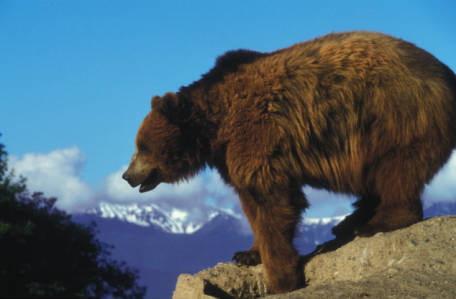“We’d like to have a say in this,” – James Walks Along, Northern Cheyenne Tribal Historic Preservation Officer at YES meeting in Cody, April 30, 2015
Recently I attended a meeting of the Yellowstone Ecosystem Subcommittee (YES) of the Interagency Grizzly Bear Committee (IGBC) in Cody, Wyoming. Comprised primarily of federal and state agency representatives charged with managing the Yellowstone grizzly bear population and its habitat, YES members meet twice a year to discuss the status of grizzly bear science and management. A key topic for the past several meetings has been the potential removal of federal Endangered Species Act (ESA) protections (“delisting”) for grizzly bears in the Yellowstone region. In the push from federal and state representatives to remove endangered species protections, a key constituency has been left out of the process--local tribes.
The lack of regard for tribal input was made abundantly clear in an incident at the meeting. The agencies gave a presentation about collaboration between the federal government and tribes, but then refused to allow James Walks Along from the Northern Cheyenne tribe to speak in response. Instead he was relegated to the 15-minute ‘public comment period’ at the end of the day. Ironically, he was there to request that the U.S. Fish and Wildlife Service, which makes the decision on delisting, formally consult with the Northern Cheyenne and other tribes on grizzly delisting. Representatives from the Shoshone Bannock Tribes of Idaho, Eastern Shoshone Tribe and Northern Arapaho Tribe, who hold seats on the YES, also requested a formal consultation process.
The Northern Cheyenne consider the grizzly bear sacred and a powerful symbol of spiritual regeneration and renewal. As Walks Along explained at the meeting, “This Holy Mountain of ours, Bear Butte, is named because of the mightiness of the grizzly. We have a lot of history with this great animal, and many stories. Grizzlies are like humans. We respect them for being like us.”
Several laws and presidential executive orders require the federal government to consult with tribes on matters affecting them. Presidential Executive Order 13647 states “Greater engagement and meaningful consultation with tribes is of paramount importance in developing any policies affecting tribal nations” and President Obama has made strong commitments to improving dialogue between tribal nations and the federal government. Yet to date, there has been no meaningful attempt by the Obama administration to involve tribes in the delisting dialogue. As noted by Dave Archambault II, Chairman of the Standing Rock Sioux Tribe, “The proposed delisting of the Yellowstone grizzly bear affects the Lakota, Dakota and Nakota people of the Great Sioux Nation….Clearly, removing the Yellowstone grizzly bear from the ESA and permitting states to proceed with high-dollar trophy hunts on our historical cultural landscape fits the criteria [for consultation]."
Grizzly bears in the lower 48 states were placed under the protection of the Endangered Species Act in 1975, when their numbers had dropped to possibly as low as 135 in the Yellowstone region. It has taken 40 years to increase their numbers to perhaps 600-700 today. Yellowstone grizzly bears remain completely isolated from any other grizzly populations, and grizzlies today occupy less than 2% of their historic habitat in the lower 48. There are significant questions about whether Yellowstone and other grizzly populations are in fact recovered, and if now is the time to remove the very protections that have allowed their numbers to rebound.
For many tribes the question is one of spiritual importance. Thirty-four other Tribal Nations have now joined the Northern Cheyenne in officially opposing delisting, including nearly all of the 26 who have ancestral ties to Yellowstone. The federal government needs to honor its commitment to consult with tribal nations on a matter that so clearly affects them, even if--or perhaps particularly since, their views of a future for grizzly bears differ.
